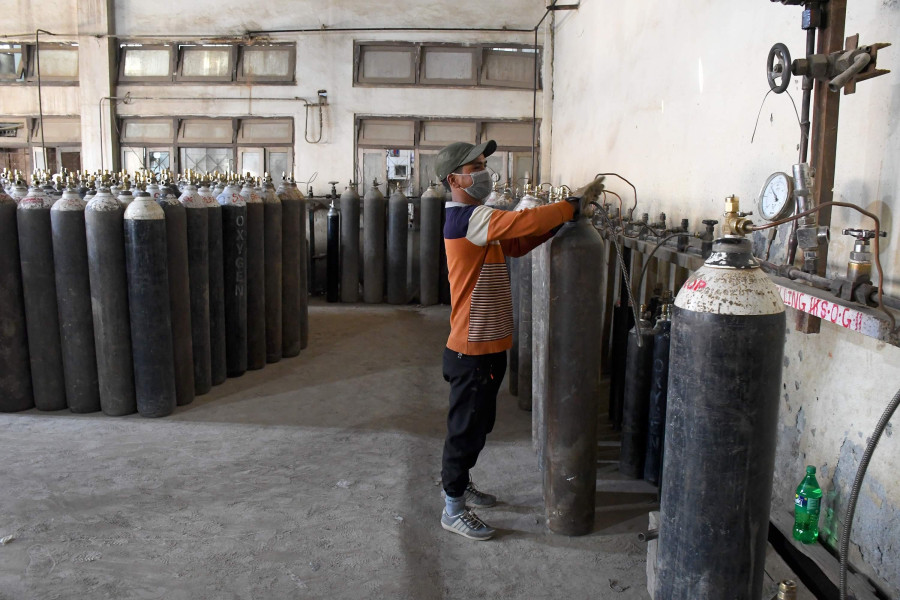National
It will take at least two months for new cylinders to arrive, gas manufacturers say
Some manufacturers fear slump in market demand for oxygen after the pandemic is over.
Prithvi Man Shrestha
Oxygen manufacturers say they have started the process to procure more cylinders as requested by the government but their delivery could take at least two months, amid a looming shortage of bottled oxygen as Covid-19 cases spiral in the country.
Manufacturers based in the Kathmandu Valley say they have the capacity to produce enough oxygen required for Covid-19 patients in the Valley at the moment and they can increase their output marginally. However, they have expressed concerns over the inadequacy of oxygen cylinders amid their potential hoarding by hospitals, businesses and ordinary people as that could lead to a shortage of cylinders.
The government last week requested the manufacturers to import at least 20,000 cylinders immediately while offering tax exemption. Subsequently, the Cabinet decided early this week to exempt customs duty, value added tax and excise duty on the import of medical goods including the cylinders.
“Right after the government decided to exempt taxes, we have initiated the process to procure 7,000 oxygen cylinders from China,” Shankar Lal Agrawal, managing director of Shankar Oxygen Udyog, told the Post. “But it will take at least two months before they are delivered to Nepal including the shipment time through the sea.”
Agrawal said manufacturers may not be able to start delivering the cylinders for at least a month after the order placement because of a growing global demand for them. “It will be expensive to get them supplied by air,” Agrawal said.
In the past, oxygen manufacturers imported cylinders even from India. Importing cylinders from the southern neighbour took less time but India itself is struggling to ease supplies at present amid spiralling cases of Covid-19. As people in India are dying without getting bottled oxygen, the Delhi High Court ordered the government last week to “buy, borrow or steal” oxygen citing the national emergency.
The oxygen crisis in India appears to have woken up the government in Kathmandu which invited the oxygen manufacturers to a meeting to discuss the health crisis last week. The manufacturers said it was the first time they were invited to discuss Covid-19 crisis since the pandemic hit the country early last year.
“Had the government made such a request 5-6 months ago, there would be enough cylinders in the country at the moment,” said Narayan Timilsina, general secretary of Oxygen Industries’ Association, who participated in the meeting organised by the government.
The government’s request for importing oxygen cylinders has come at a time when the government itself is warning the general public that the healthcare system of the country is collapsing.
“The healthcare system is overwhelmed as the number of infections has been increasing rapidly. Already, hospital beds are becoming scarce,” said the Health Ministry in a statement on Friday.
According to the association, many of them have started placing orders for oxygen cylinders after the government decided to exempt taxes on cylinder imports.
“Around 500 cylinders that we had ordered, are on the way and they are expected to arrive in Nepal in the next two weeks,” said Gaurav Sharda, director of Kantipur Oxygen Pvt. Ltd. “We are also holding discussions with the suppliers to place more orders.”
Sharda, who is also the president of the association, said that they are preparing to import extra cylinders from China in line with the government’s request. But he expects it would take more time for delivery of cylinders as long as they are brought by air which is an expensive mode of transportation.
However, manufacturers say many of them are hesitant to invest on new cylinders as they are not sure whether the demands would continue to remain higher even after the pandemic is over.
“Before this pandemic, our industries were operating at just 30 percent of their capacity,” said Sharda. “There is a fear that demands may slump right after the pandemic is over and that our investment will go to waste.” According to the Oxygen Industries’ Association, its members have an estimated 70,000-80,000 oxygen cylinders.
Citing the potential losses, Sagarmatha Oxygen Nepal Pvt Ltd is not in any haste to import more cylinders.
“Right now we have no plans to import oxygen cylinders as long as the market is not guaranteed for extra capacity after the pandemic is over,” a company representative said.
According to the association, which represents eight oxygen manufacturers in the Kathmandu Valley, currently, they are supplying around 6,000 cylinders per day, out of their combined capacity of 8,000 cylinders per day.
There are 24 private sector manufacturers of oxygen nationwide, according to the association. As most of the hospitals in the country don’t have their own oxygen plants, private sector manufacturers supply the oxygen for them. Given the fear of slump in market demand post pandemic, the manufacturers are of the view that the government itself could procure the cylinders through government-to-government deals from abroad. “Once the new cylinders are brought to the hospitals, we are ready to refill them,” said Sharda.
But all manufacturers don’t have the same view regarding the market for extra cylinders. Agrawal said that the oxygen market has been growing 15-20 percent every year and the market could be available for extra capacity of the oxygen industry. “We have been adding 1,500 to 2,000 cylinders every year,” said Agrawal, who has two plants— one in Kathmandu and another in Bhairahawa with combined production capacity of 1,800 cylinders per day.
But the new supply of oxygen cylinders planned by him is expected to take more time to arrive. With the coronavirus cases surging, there is a fear of the country facing an acute shortage of oxygen like in India. On Friday, Nepal reported 5,657 cases, the second highest daily count to date after 5,747 cases reported on October 2 last year.
“The best option at the moment is to rotate the existing cylinders and utilise our capacity to the maximum,” said Agrawal.




 15.69°C Kathmandu
15.69°C Kathmandu







%20(1).jpg&w=300&height=200)






